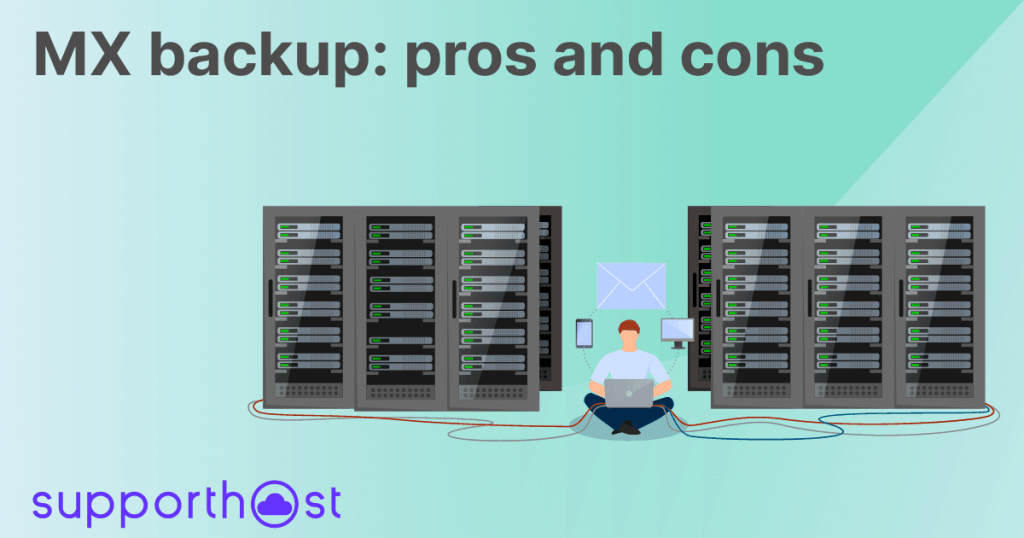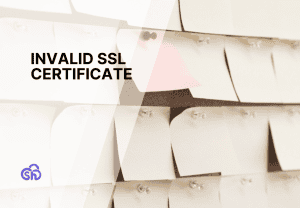Let’s find out what an MX backup is for and why it’s important to be prepared if your email server goes offline.
We’ll see how email sending works, what an MX record is and what’s the point of having more than one. Then we’ll also look at the possible drawbacks of the service and whether or not it’s possible to mitigate them.
Table of Contents
What is an MX record?
MX is short for Mail Exchanger. But what is an MX record?
An MX record is a DNS record that points to the email server which handles mail and is associated with a particular domain. In the absence of an MX record, if it is not configured, it would still be possible to send emails but not receive them.

Each MX record contains essential information:
- the domain name
- the mail server
- the priority
To understand what role MX records play, let’s see how the process of sending an email works.
What happens when an email is sent?
There are several players involved in sending an email.
The first one to be involved is the email client, the Mail User Agent (MUA) through which the email is sent. The Mail User Agent connects to the sending server, using the SMTP protocol.
The next step requires the intervention of the Mail Transfer Agent (MTA), i.e., the program that must contact the destination server. Once the message reaches its destination, it is passed to the Mail Delivery Agent (MDA) which allows it to arrive at the recipient’s mailbox.

The sending server must interrogate the DNS of the domain to which the email is destined in order to obtain the IP address and deliver the email. The resolution of the IP address is completed thanks to the MX records.
Resolving an IP address means nothing else than translating a textual address, i.e. the domain name, to the real IP, i.e. the address of the email server.
Specifically, the MX record enables the identification of the server on which the email box is hosted. The resolution of the IP address is done thanks to another DNS record (usually the A record).
An MX record looks like this:
| Host | Type | Priority | Email server |
| exsampledomain.com | MX | 10 | mail.exsampledomain.com |
Why have more than one MX record?
Multiple MX records can be set up for a single domain. Each MX record can be assigned a value to assign a priority.
The lower the value assigned, the higher the priority.Let’s quickly see what this means through an example.
Let’s take the example of a domain esempio.it for which we want to set two MX records:
mail1.esempio.it with priority 5
mail2.esempio.it with priority 10.
In this case the server mail1.esempio.it will be used with priority. If this server is not available, emails will be redirected to server mail2.esempio.it.
It is also possible to assign the same priority to more than one MX record. In this case, if the priority is the same, one of the two servers will be chosen randomly. In essence, the two servers will share the workload.
Generally, moreover, the priority is used precisely to define:
- the main mail server, i.e. the one with the highest priority and therefore the lowest numerical value
- a backup mail server, i.e. the one with the lowest priority and therefore a higher value.
Let’s see what happens when there is only one MX record and therefore only one mail server and when, instead, several mail servers are associated with a single domain.

When a domain uses only one mail server when an email is to be delivered the Mail Transfer Agent (MTA) will access the MX records and find only one corresponding server.
In this case, there is no need to refer to the priority number, since there is only one server. Therefore, the delivery attempt to the indicated destination server will start immediately.
In case the destination server is not reachable, the email cannot be delivered.
This is where the MX backup comes in useful. Let’s come to the second case.
When the MTA is faced with a number of different MX records, it will have to deliver according to the priority set.
The first server that will be tried to reach will be the one with the highest priority. If the first attempt fails, the second one will be contacted in order of priority and so on until the delivery is successful.
Of course, if there are more than one MX records with the same priority, for example, an MX backup with the same priority, the delivery will be attempted to these before continuing with those with lower priority.
Let’s see this case with an example with these three different MX records:
mail1.esempio.it with priority 10
mail2.esempio.it with priority 10
mail3.esempio.it with priority 20.
The first two servers have the same priority, 10, which is the highest priority. In this case, the first attempt will be made with server mail1 or mail2 with no preference for one or the other.
Let’s assume that the attempt to send to server mail1.esempio.it fails. The client, then, will try to send the email to the server mail2.esempio.it. If this attempt also fails, it will proceed with the server mail3.esempio.it.
Email uptime 100%
The presence of an MX backup ensures that email messages always reach their destination.
It may happen that the primary MX server is unreachable. For example, the server may be down for maintenance or there may be a problem with the infrastructure.
With an MX backup, redundancy is ensured and no email can be lost even if the primary server is not responding.
In this case, in fact, the backup server receives the messages and keeps them (even for more than 10 days) until the primary server becomes available again. As soon as the primary server is up and running again, emails are routed to the latter.
Disadvantages of an MX backup
Spammers can specifically target an MX backup server. The goal is to get past the spam filters on the primary MX, assuming these rules are not applied on the MX backup which will tend to receive all emails without filtering them.

To mitigate this problem we use our own proprietary rules, so your email accounts won’t be targeted by spam and you can enjoy the benefits of an MX backup without ever losing any emails.
How to use the MX backup
At SupportHost, we want your emails to be safe at all times. That’s why we’ve made MX backup available on all plans from shared hosting, WordPress hosting and semi-dedicated hosting to dedicated VPS cloud hosting and dedicated server solutions.
To use the service you will need to use our nameservers:
ns.supporthost.com
ns.supporthost.eu
ns.supporthost.net
ns.supporthost.us
You can follow our tutorial to verify or change the nameservers of your domain.
Use MX backup with CloudFlare
You can also use the MX backup service if you use CloudFlare. In this case you have two options.
The first, which is the simplest method, is to set up our nameservers and wait for the domain to point correctly. You can check our tutorial to understand how to make sure the pointing is correct.
Then going to set up CloudFlare the MX backup records will be imported automatically.
The second alternative is to set up CloudFlare manually. To do this you’ll have to add these two records in addition to the primary MX record (which must have a priority lower than 30 in this case):

Conclusion
As we have seen the MX backup allows you to continue to receive emails even if the main server is unreachable. It could happen that there is a failure or that the server is temporarily not working due to maintenance, no matter what happens your emails are safe and will never be lost.
Moreover, with SupportHost the MX backup service is free and available for all our plans.
Were you aware of the advantages of this service?
Have you ever had problems with receiving emails? Let me know in the comments below.





Leave a Reply